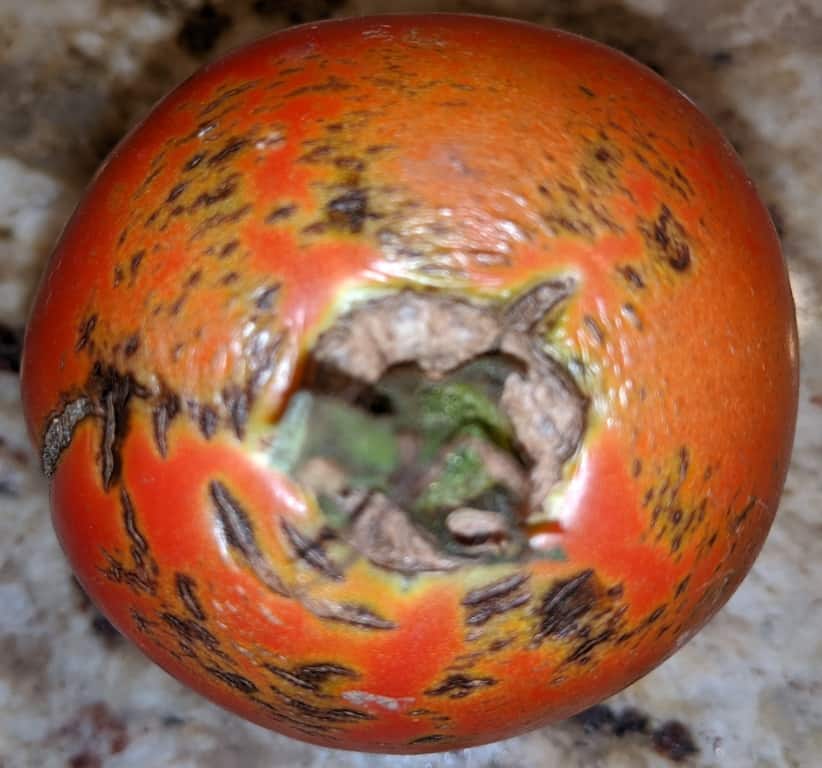
When walking out to your garden after heavy rain it can be frustrating to see some of your growing tomatoes split and cracking. It can happen at any stage of a tomato’s development whether they are ripe or green.
Through my own experience and research, I will discuss why tomatoes split on the vine during the growing season, the growing conditions that cause it, and ways you can prevent it.
Why Do Tomatoes Split and Crack?
The tomato skin cracks and splits due to rapid changes in the moisture level of the soil caused by heavy rain often after a dry weather period. This causes the tomato to expand faster than its skin can grow resulting in splitting and cracking.
Tomatoes can split on the vine during all the stages of growth but as their color develops they become more susceptible.
Certain varieties are more resistant than others. Picking a tomato at the breaker stage is one way to reduce splitting.
Tomatoes split in two ways. You will see circular cracks that start near the stem (seen below) and vertical splits on the sides of the tomato.
Many of the heirloom tomato varieties form concentric cracking at the top after heavy rains but it’s a small price to pay for a great tasting tomato.

Why is a split tomato a problem?
When a tomato’s outer skin splits or cracks at the top it makes it easier for insects, bacteria, and fungus to enter the fruit causing it to rot or be eaten by pests.
A ripe tomato is more likely to split compared to a green one.
However, that does not mean they have to be thrown out depending on the circumstances.
6 Ways to keep tomatoes from splitting and cracking
1. Water your tomatoes regularly
Tomatoes need 1 to 2 inches of water per week. By watering your tomato plants every 2 days during the hot summer they should receive an adequate amount.
When you water your tomato plant do so at the base of the plant being careful not to splash soil on the leaves as this could spread soil-born diseases on the plant such as Anthracnose which causes tomato rot.
Don’t water the leaves and foliage at the top as this can lead to blight problems down the road.
By watering your tomatoes on a regular schedule the soil moisture will maintain a more even temperature so that when it rains the temperature change will not be as abrupt.
You can also set up a drip irrigation system to make the process easier.
2. Provide good drainage for tomatoes
Creating soil mounds or raised beds for your tomatoes reduces the risk of disease from the soil that remains wet for a period of time.
Use a good loose soil that does not compact to easily.
If your tomato plants are potted, make sure there are drainage holes at the base of the pot so excess water can drain out.
3. Mulch around your tomatoes
Spreading organic mulch at the base of your tomato plants helps the soil retain moisture preventing sharp moisture changes when it rains.
Some of the best types of mulch for tomatoes include grass clippings, hay, straw, leaves, or compost. A layer of 2 to 3 inches is ideal.
You can also use dark black plastic mulch though I prefer more organic methods.
4. Grow resistant varieties of tomatoes
Certain varieties are more resistant to cracking than others when buying seeds or small plants read the label and see if it mentions being “crack-free”.
Some resistant varieties include Rutgers, Marglobe, First lady, Sungold, Big boy, Big Beef, Red sun, and Burgess crack proof.
5. Pick your tomatoes before a heavy rain
By picking your ripening tomatoes before a rapid moisture change you can prevent splitting tomatoes and save the flavor of the tomato.
You can pick tomatoes from the vine as soon as they reach the breaker’s stage which is when they start turning a slight pink. These breakers stage tomatoes and fully mature green tomatoes will continue the ripening process once picked.
By picking tomatoes at this stage you also free up the energy of the plant to focus on producing other tomatoes. You can read more in my article about the tomato ripening process.
6. Provide adequate calcium for your soil
Having the right amount of calcium in your soil allows the tomato to better regulate its water uptake. You should add calcium at the beginning of the planting season.
Calcium also will help prevent blossom end rot of your tomatoes.
You can add eggshells to your soil or compost as they contain calcium, you can also add Dolomite Lime (Calcium carbonate), hardwood ashes, Gypsum (Calcium sulfate), and other fertilizers that contain calcium.
What should I do if my Tomatoes split?
If your tomatoes have split harvest them quickly. The exposed fruit is more susceptible to rot, insects, and other pests.
Split tomatoes do not last as long since the fruit is exposed so you should cut around the cracks and use them for, sauces, salsas, and salads.
Are split tomatoes safe to eat? Is it ok to eat cracked tomatoes?
Cracked and Split tomatoes are safe to eat if you catch them quickly enough.
If they have a sweet smell then they should be ok but if the tomato crack is starting to ooze or has a sour smell then do not eat those and put them in the compost pile.
I always cut the cracked part off the tomato and use the rest for salads and sandwiches.
Seeing your tomatoes splitting is never a welcome sight but hopefully, you can reduce or prevent the problem completely using these tips. Happy Harvesting.




